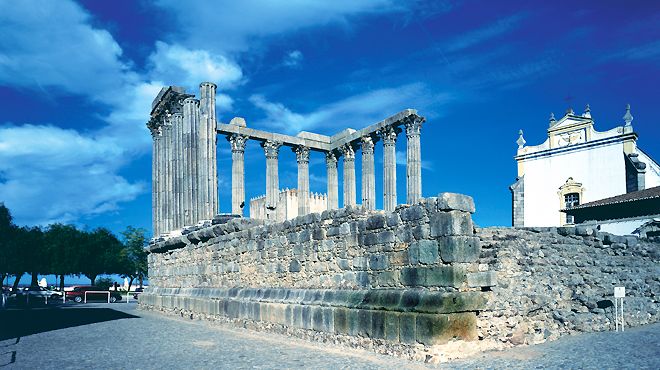The Roman Temple and the Cathedral

The Roman Temple and the Cathedral
Other
The starting point on this itinerary is by Roman temple. Dating back to the second century, this is the jewel in Evora´s glittering crown.
Many of the elegant columns remain intact rising up to finely decorated Corinthian points.
To the north of the temple, there is a garden that extends to the Roman wall. This is the place for panoramic views out over the huge Alentejan plain.
To the south of the temple, located in the now restored building that used to be the convent of John the Evangelist (15th century), there is the charming surroundings of the Pousada dos Lóios (Lóios Country Hotel). Well worth a visit is the convent´s church with its entrance around the side. Built towards the end of the 15th century, the gothic door is an important feature along with the tiled finishings.
The building enclosing the church is the Palace of the Dukes of Cadaval (also known as the Palace of the Five Shields) that used to be the residence of this leading Portuguese family. It was topped by battlements and flanked by two imposing towers and provides a fine example of a noble residence. In the quadrangular tower Fernando, Duke of Bragança, was imprisoned in 1483 accused of conspiring against king João II. He left only for his beheading in the Praça do Geraldo.
In the palace, there is also the interesting Museum of the House of the Dukes of Cadaval.
Behind the Pousada (country hotel), the Marqueses de Marialva square is dominated by the imposing structure of the Sé de Évora which contains the Museum of Religious Art in one of its towers.
Over in front, there is the former Palace of the Inquisition, founded in 1536. Over the pediment, there are the tools used by the horrific Inquisition. In Évora alone, over 22,000 people were condemned.
Moving past the Sé, in the Praça Conde Vila Flor, in the Episcopal Palace, there is the Museum of Évora which boasts a valuable art collection.
On the right of the square there is the Casas Pintadas street. On this street, in a house currently home to Jesuit priests, Vasco da Gama, discoverer of the sea route to India, lived between 1519 and 1524.
In the house, there is a small Manueline cloister decorated with frescos depicting mermaids and fantasy animals featuring the imaginative dimension to the voyages of Discovery.
Many of the elegant columns remain intact rising up to finely decorated Corinthian points.
To the north of the temple, there is a garden that extends to the Roman wall. This is the place for panoramic views out over the huge Alentejan plain.
To the south of the temple, located in the now restored building that used to be the convent of John the Evangelist (15th century), there is the charming surroundings of the Pousada dos Lóios (Lóios Country Hotel). Well worth a visit is the convent´s church with its entrance around the side. Built towards the end of the 15th century, the gothic door is an important feature along with the tiled finishings.
The building enclosing the church is the Palace of the Dukes of Cadaval (also known as the Palace of the Five Shields) that used to be the residence of this leading Portuguese family. It was topped by battlements and flanked by two imposing towers and provides a fine example of a noble residence. In the quadrangular tower Fernando, Duke of Bragança, was imprisoned in 1483 accused of conspiring against king João II. He left only for his beheading in the Praça do Geraldo.
In the palace, there is also the interesting Museum of the House of the Dukes of Cadaval.
Behind the Pousada (country hotel), the Marqueses de Marialva square is dominated by the imposing structure of the Sé de Évora which contains the Museum of Religious Art in one of its towers.
Over in front, there is the former Palace of the Inquisition, founded in 1536. Over the pediment, there are the tools used by the horrific Inquisition. In Évora alone, over 22,000 people were condemned.
Moving past the Sé, in the Praça Conde Vila Flor, in the Episcopal Palace, there is the Museum of Évora which boasts a valuable art collection.
On the right of the square there is the Casas Pintadas street. On this street, in a house currently home to Jesuit priests, Vasco da Gama, discoverer of the sea route to India, lived between 1519 and 1524.
In the house, there is a small Manueline cloister decorated with frescos depicting mermaids and fantasy animals featuring the imaginative dimension to the voyages of Discovery.




 Explore
Explore 
 Remember and Share
Remember and Share 


